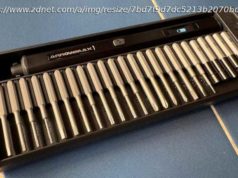The Fujifilm Fujinon XF 27mm F2.8 is a tiny prime lens for Fuji X cameras. It’s very sharp in the center, but edge performance isn’t the greatest.
Fans of compact prime lenses are sure to be excited by the Fujifilm Fujinon XF 27mm F2.8 ($449.95). The slim lens is compatible with Fuji’s X mirrorless system, making some of the smaller cameras available almost pocketable. It doesn’t have an aperture ring, which will turn off some Fuji owners, but delivers strong image quality in a small package. It’s a good lens, though not quite as good as the slightly larger XF 23mm F2 R WR, which is brighter and includes protection from dust and splashes for the same price.
Let’s talk about size—it’s the XF 27mm’s biggest draw. The lens measures 2.4 by 0.9 inches (HD) and weighs just 2.8 ounces. It almost feels like nothing when attached to your camera, and I was able to slide an X-E3 into the pocket of my winter coat with ease with the lens attached. There’s no hood, although you can use 39mm front filters if desired. You can get it in black or silver.
The angle of view is about 40mm, in full-frame terms, when paired with an APS-C camera. It’s a little wider than what you think of as standard angle, but not quite as wide as a 35mm or 28mm-equivalent prime. I like it as a focal length; I often struggle composing shots with a 35mm-equivalent lens, but find things to be a bit more natural with the 40mm frame. Your mileage may vary, of course.
You don’t get a physical aperture ring, a rarity for the Fujifilm system. Instead you’ll need to change the f-stop using the camera body controls. Some older models may require a firmware update to make this work, but newer cameras will have no problem recognizing and controlling the lens. Optical stabilization is also omitted, but that’s not surprising—it’s something you don’t typically find on lenses of this type.
There’s also no weather sealing, which is included on the 23mm F2. If you use a body without seals this isn’t a concern, but if you have an X-Pro2 or X-T2, be careful not to use it in rough weather with the 27mm attached.
The 27mm focuses as close as 13.4 inches (0.34m), which is a bit limiting. Pancake designs often omit close focus capability, and the 27mm’s meager 1:10 magnification ratio doesn’t buck that trend. I found myself having to back up to get shots from time to time. It’s one of the prices you pay for the design; the XF 23mm F2 gets you just a little bit closer to subjects, focusing to 8.7 inches for 1:7.7 magnification.
I found autofocus speed to be quite good when shooting with the X-E3. The 27mm locked onto a focus target quickly and reliably, in about 0.1-second. But it’s only good for use in AF-S mode. Switching to continuous (AF-C) focus caused the lens to hunt back and forth eratically, delivering generally unreliable performance. AF-C is more often used for telephoto shooting, so this wasn’t a big deal in practical terms, but it’s something to be aware of. If you like to track moving subjects, use a different lens.
I paired the 27mm wiht the 24MP X-E3 to see how it performs. Imatest’s standard center-weighted sharpness test show that it does well, notching 2,659 lines per picture height at f/2.8, with strong performance right up to the edges of the frame. It’s not as sharp as the 23mm F2 at f/2.8 (3,104 lines), but the 27mm is still in the very good range of quality wide open.
See How We Test Digital Cameras
At f/4 the resolution improves (2,904 lines), and it peaks at f/5.6 (3,218 lines) and f/8 (3,277 lines), both excellent results. There’s a slight drop at f/11 (3,008 lines), and a more noticeable one at f/16 (2,562 lines).
Distortion is controlled, there’s only 0.8 percent visible, which is negligible in the real world. Likewise, corner illumination is strong. The lens doesn’t cast a noticeable vignette, even shot wide open the corners lag behind the center by just 0.9EV.
The XF 27mm F2.8 doesn’t have a sexy f/2 or f/1.4 maximum aperture, but its slim design is unmatched by other lenses available for the Fujifilm X system. It delivers sharp results, right up to the edge of the frame, and when stopped down can go toe to toe with the sharpest lenses available for the system. It’s not without some issues—it doesn’t focus that close, and you don’t want to use it with tracking focus enabled. If you’re willing to live with those compromises, you’ll appreciate its size. We rate another small, although not pancake, lens higher—the XF 23mm F2 R WR captures twice the light at its widest setting, is sharper at f/2.8, and includes an aperture ring and protection from dust and splashes, all for the same price.
Bottom Line: The Fujifilm Fujinon XF 27mm F2.8 is a tiny prime lens for Fuji X cameras. It’s very sharp in the center, but edge performance isn’t the greatest.






